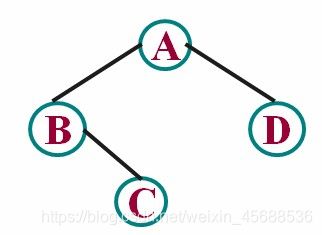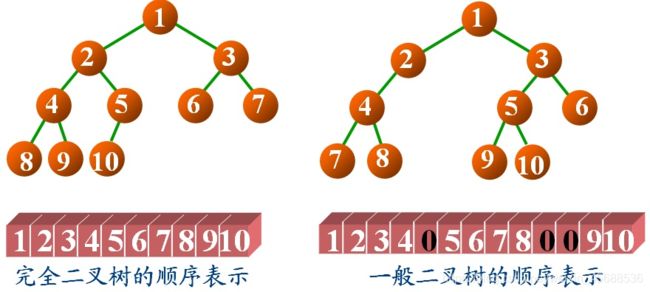数据结构之二叉树练习
1.二叉树的结构
- 二叉链表结构:
struct BiNode{
char data;
BiNode* lChild;
BiNode* rChild;
BiNode():lChild(NULL),rChild(NULL){}
}
- 三叉链表结构
struct BiNode{
char data;
BiNode* lChild;
BiNode* rChild;
BiNode* father;
BiNode():lChild(NULL),rChild(NULL),father(NULL){}
}
2.二叉树的创建
- 给出先序遍历的字符串,空树用 ‘#’ 表示(有些用‘0’),根据给出的先序遍历结果创建二叉树。
- 二叉链表代码:
void CreateBiTree(BiNode* &T){
char ch;
cin >> ch;
if(ch == '#'){
T = NULL;
}else{
T = new BiNode();
T->data = ch;
CreateBiTree(T->lChild);
CreateBiTree(T->rChild);
}
}
这里函数参数中的&号是必需的,因为我们需要改变传入的指针自身的值。否则无法成功创建树。
- 三叉链表代码:
BiNode* CreateBiTree(BiNode* T){
BiNode* p;
char ch;
cin >> ch;
if(ch == '#'){
p = NULL;
}else{
p = new BiNode();
p->data = ch;
p->father = T;
p->lChild = CreateBiTree(p);
p->rChild = CreateBiTree(p);
}
return p;
}
注意在主函数中要用根结点指针去接收函数最后返回的值。即T = CreateBiTree(T);
3.二叉树的遍历
- 这里主要展示后序遍历非递归的代码,因为三种遍历方式的递归程序和先序遍历、中序遍历的非递归程序很好理解,自己多看代码即可。
void PostOrderTraverse(BiNode* T){
int tag = 0;
stack<BiNode *> s1;
stack<int> s2; //(1)
BiNode *p = T;
do{
if(p){
s1.push(p);
tag = 0;
s2.push(tag);
p = p->lChild;
}else{
if(s2.top() == 0){
tag = 1;
s2.top() = tag;
p = s1.top()->rChild; //(2)
}else{
p = s1.top();
s1.pop();
s2.pop();
cout << p->data;
p = NULL; //(3)
}
}
} while (!s1.empty());
}
这里有三点需要注意:
(1) 每次遍历根结点先进栈,但是在访问完左子树和右子树时当前指针p都是空的。访问完左子树时根结点还不能出栈,只有当右子树访问完毕后,根结点才能出栈并输出其数据。因此这里使用了另外一个状态栈,通过0和1标志当前访问完的是左子树还是右子树,决定根结点是否需要出栈。
(2) 由于当前p是空的,因此需要用栈顶元素来访问右子树,即s1.top()。
(3) 在访问完根结点的左右子树和它本身之后,程序需要回到当前根结点的父节点去继续往后访问。因此要在这里把p置空。
4.求二叉树的叶子数目
- 叶子指的是没有孩子的结点。这里采用递归的方法去查找。
int countLeaves(BiNode* T){
if(T && T->lChild == NULL && T->rChild == NULL){
return 1;
}else if(T){
int left = countLeaves(T->lChild);
int right = countLeaves(T->rChild);
return left + right;
}
return 0;
}
在思考时要注意叶子结点的特点:当前结点不为空,左右孩子结点都为空。 如果当前结点不空,而且至少有一个孩子不空时,说明它不是叶子结点,要继续往下判断;而当前结点为空时,程序不能再往下了,这里返回0即可。这里将左右子树寻找的结果加起来,即可得到最终的结果。
5.求二叉树的高度
int getHeight(BiNode* T){
if(T){
int left = getHeight(T->lChild);
int right = getHeight(T->rChild);
if(left > right){
return left + 1;
}else{
return right + 1;
}
}else{
return 0;
}
}
算法思路:求二叉树的高度是找到从根结点到叶子结点路径最长的一条。我们可以先一路走到底,即找到叶子结点的孩子(空节点),然后一步步返回,每返回一层就在原来的基础上加1记录层数,同时每返回到一个结点时比较它左右子树的层数,取大的值再继续往上返回。这里就相当于从下往上计算高度了。
6.应用(例题分析)
例1:DS二叉树——二叉树之数组存储
题目描述:
二叉树可以采用数组的方法进行存储,把数组中的数据依次自上而下,自左至右存储到二叉树结点中,一般二叉树与完全二叉树对比,比完全二叉树缺少的结点就在数组中用0来表示。,如下图所示
从上图可以看出,右边的是一颗普通的二叉树,当它与左边的完全二叉树对比,发现它比完全二叉树少了第5号结点,所以在数组中用0表示,同样它还少了完全二叉树中的第10、11号结点,所以在数组中也用0表示。
结点存储的数据均为非负整数
输入:
第一行输入一个整数t,表示有t个二叉树
第二行起,每行输入一个数组,先输入数组长度,再输入数组内数据,每个数据之间用空格隔开,输入的数据都是非负整数
连续输入t行
输出:
每行输出一个示例的先序遍历结果,每个结点之间用空格隔开
样例输入:
3
3 1 2 3
5 1 2 3 0 4
13 1 2 3 4 0 5 6 7 8 0 0 9 10
样例输出:
1 2 3
1 2 4 3
1 2 4 7 8 3 5 9 10 6
提示:注意从数组位置和二叉树深度、结点位置进行关联,或者父子结点在数组中的位置存在某种管理,例如i, i+1, i/2, i+1/2……或者2i, 2i+1……
这里只给出创建二叉树、求高度、先序遍历的代码。
void CreateBiTree(BiNode* &T, int* arr, int h, int H, int i, int len){
if(i > len || h > H){
T = NULL;
}else{
T = new BiNode;
T->data = arr[i];
CreateBiTree(T->lChild, arr, h + 1, H, 2 * i, len);
CreateBiTree(T->rChild, arr, h + 1, H, 2 * i + 1, len);
}
}
int len, height;
cin >> len;
int *arr = new int[len + 1]; //0号空间不用
for (int i = 1; i <= len; i++){
cin >> arr[i];
}
for (int i = 1;; i++){//求高度
if(pow(2, i) - 1 > len){
height = i;
break;
}
}
void PreOrderTraverse(BiNode* T){
if(T){
if(T->data){
cout << T->data <<' ';
}
PreOrderTraverse(T->lChild);
PreOrderTraverse(T->rChild);
}
}
例2:DS二叉树–左叶子数量
题目描述:
计算一颗二叉树包含的叶子结点数量。
左叶子是指它的左右孩子为空,而且它是父亲的左孩子
提示:可以用三叉链表法,也可以用现有算法对两层结点进行判断。
建树方法采用“先序遍历+空树用0表示”的方法
输入:
第一行输入一个整数t,表示有t个测试数据
第二行起输入二叉树先序遍历的结果,空树用字符‘0’表示,输入t行
输出:
逐行输出每个二叉树的包含的左叶子数量
样例输入:
3
AB0C00D00
AB00C00
ABCD0000EF000
样例输出:
0
1
2
#include这里计算叶子数时,为了判断是否为左子树加了一个标志flag,flag=1表示当前叶子为左叶子。
例3:DS二叉树——二叉树之父子结点
题目描述:
给定一颗二叉树的逻辑结构如下图,(先序遍历的结果,空树用字符‘0’表示,例如AB0C00D00),建立该二叉树的二叉链式存储结构。编写程序输出该树的所有叶子结点和它们的父亲结点。
输入
第一行输入一个整数t,表示有t个二叉树
第二行起,按照题目表示的输入方法,输入每个二叉树的先序遍历,连续输入t行
输出:
第一行按先序遍历,输出第1个示例的叶子节点
第二行输出第1个示例中与叶子相对应的父亲节点
以此类推输出其它示例的结果
样例输入:
3
AB0C00D00
AB00C00
ABCD0000EF000
样例输出:(每个字符后有空格)
C D
B A
B C
A A
D F
C E
#include这里我使用了一个全局变量的计数器(数组指针),在找到叶子结点时将叶子和其父结点的数据分别加入数组内存储,并将指针往下。同时对叶子结点进行计数并返回,但是其实可以直接使用全局的计数器 i,意思是一样的,读者可以自己尝试修改。


